
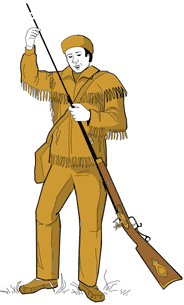

A piece of flint is held in a "cock." When you move the
cock to the rear and
pull the trigger, the cock moves forward. The flint strikes the steel,
causing sparks to fall into the flash pan. This ignites the priming powder.
The priming powder burns, igniting the main black powder charge in the
bore.
The flintlock system does not work well in rain or wind and requires
shooters to carry two different types of black powder.

The world saw many changes from 1850-1900 in the
development of firearms and ammunition. Muzzleloading firearms were replaced
with breech-loading firearms, otherwise known as our modern firearm.

The modern firearm barrel is loaded from the rear or breech of the barrel.
This allows for quicker reloading. Modern ammunition is far more dependable
than black powder, especially in poor weather conditions such as rain
or snow.
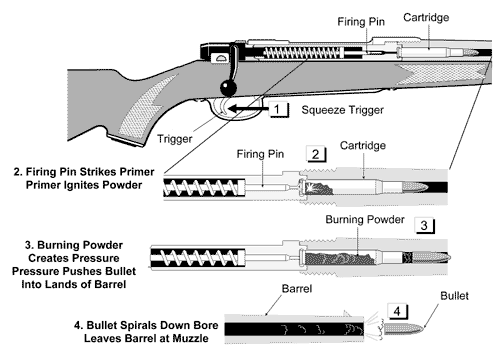

Modern firearms can be classified as
In each of those classifications you will find
rifles, shotguns and handguns.


Manual-repeating firearms allow shooters to fire more quickly. Simply by working the action, the shooter could eject a cartridge from the chamber and then load a new cartridge from the magazine.
A lever action rifle is an example of a manual repeating firearm.

Fully automatic means that with a squeeze of the trigger the firearm keeps shooting until you release the trigger or run out of ammunition. Fully automatics are generally only used for military and police purposes today.
|
Rifle |
Shotgun |
|
|
Grooved Bore Single Projectile Long Range Front & Rear Sights |
Smooth Bore Multiple Projectiles Short Range Front Sight Only |
 |
A rifle gets
its name from the presence of spiral grooves in the bore called
"rifling." These grooves spin the bullet, thereby increasing
the rifle's range and accuracy. |
| A shotgun's barrel wall is thinner than that of a rifle and its bore or inside surface is smooth. |
| A rifle cartridge has a single bullet or projectile contained in a case. | A shotgun shell has a number of shot pellets inside a paper or plastic hull. | |
 |
 |
The caliber is a direct measure of the inside diameter of a rifle barrel. It is expressed in hundredths of an inch; for example, a .22 caliber rifle has a bore of 22/100 inch in diameter. It can also be given in metric terms such as 5.56 mm.
The gauge refers indirectly to the bore diameter of a shotgun.
It is not a direct measure, but is calculated as the number of lead balls
of a bore diameter required to make up one pound. This is an old British
measurement system. Thus, a 16-gauge shotgun has a bore diameter such
that 16 lead balls of the bore diameter would weigh a pound. 
Gauge measurement has no connection to the variety of shot sizes that may be found in shotgun ammunition. The one exception to the indirect measurement of gauge is the .410 shotgun. In this case, the measurement refers directly to the actual bore diameter or caliber.
ActionsActions contain the parts that load, unload and fire the cartridge. Actions come in various styles. You will find rifles, shotguns, and handguns with these actions. Let's look at the parts of the action: frame, trigger, safety, magazine and action release. How these parts are assembled determine a firearm's action. |
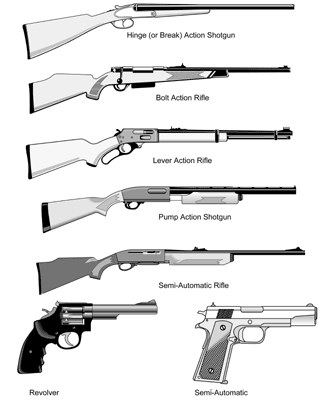 |
|
Tubular
Magazines |
Box-type
Magazines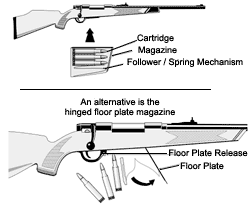 |
 A
bolt action firearm operates on a lift, pull and push sequence similar
to a door bolt.
A
bolt action firearm operates on a lift, pull and push sequence similar
to a door bolt.
On some models of bolt action the action may not open if the safety is
on. Release the safety and then open the action.
If the bolt action rifle has no magazine it is a single shot firearm.
If the bolt action rifle is equipped with a magazine it is classified
as a manual-repeating firearm.
To load a bolt action firearm, the shooter will install the ammunition in the magazine. When the shooter closes the action a round of ammunition will be fed from the magazine into the chamber. By simply operating the action the shooter will eject and load ammunition from the magazine.
![]() Open
the action by pulling the handle in a downward direction, pivoting it
towards the barrel. This movement ejects any cartridges or shells and
brings new ammunition up from the magazine. Normally, lever action rifles
have tubular magazines. Some may have a box magazine.
Open
the action by pulling the handle in a downward direction, pivoting it
towards the barrel. This movement ejects any cartridges or shells and
brings new ammunition up from the magazine. Normally, lever action rifles
have tubular magazines. Some may have a box magazine.
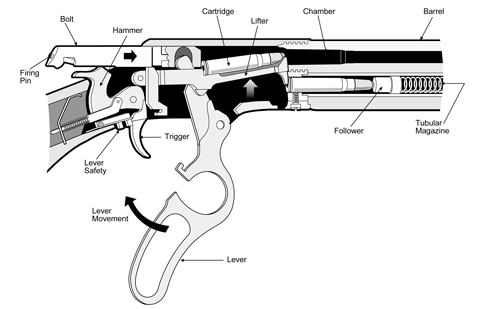
Some models of semi-automatics lock open when the firearm is empty.
How semi-automatic firearms work:
Semi-automatic firearms are either recoil- or gas-operated. Gas-operated means that some of the pressure from the fired cartridge is tapped off the barrel and pushes a piston backwards, causing the action to open.
No matter whether a semi-automatic firearm is recoil- or gas-operated, it is important to keep the firearm clean and use proper ammunition.


Revolvers come in either single or double action. A single-action revolver must be manually cocked first, then the trigger is squeezed before it can fire. A double-action revolver is cocked and fired in one motion when the trigger is squeezed.


![]() The
center-fire cartridge has a primer located in the center of the base.
The
center-fire cartridge has a primer located in the center of the base.
![]() The
rim-fire cartridge has no noticeable primer. Instead, the priming compound
is placed and spun into the case rim. When the rim is struck by the
firing pin, the priming compound explodes, igniting the powder.
The
rim-fire cartridge has no noticeable primer. Instead, the priming compound
is placed and spun into the case rim. When the rim is struck by the
firing pin, the priming compound explodes, igniting the powder.
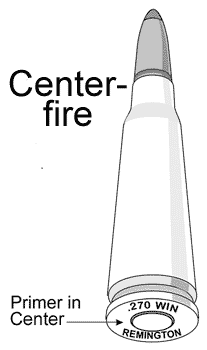

Bullets come in different shapes and sizes, and are commonly made of lead. Some bullets have a metal jacket, making them travel faster. Full metal-jacketed bullets cannot be used for hunting! They are okay for target shooting.
Ballistics is the science that studies the motion of projectiles. Changing ammunition changes the ballistics for your firearm.
For example, a .30-06 Springfield cartridge with a 180-grain bullet has different ballistics than the same cartridge with a 150-grain bullet.

